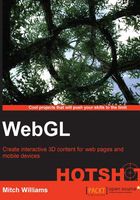
What this book covers
Project 1, Building Great Web3D, introduces us to 3D graphics concepts—lights, cameras, 3D meshes, and their placement in 3D space, plus animation with X3D.
Project 2, WebGL for E-Commerce, describes how to build e-commerce sites in 3D using existing assets while introducing WebGL technology including shader programming inside the GPU. Then, we look at the issues and opportunities in building a WebGL 3D e-commerce site.
Project 3, User Experience, Story, Character, Visual Design, and Interactivity, applies shader languages to texture maps in order to create effects such as flags waving in the wind and waterfalls. Then, we will create engaging night scenes with lighting and fog when navigating 3D scenes.
Project 4, Mobile and Web3D Gaming, builds 2D user interfaces in a 3D environment, common in video games. We will then implement features of games such as misdirection to create challenges in games and implement gravity.
Project 5, Social Media Meets Its Destiny, interfaces WebGL with Facebook, the social media website, in order to build 3D interfaces to visit your Facebook friends. Also, we will learn about the Facebook programming interface to expand our applications.
Project 6, 3D Reveals More Information, demonstrates how to display data from a real-time Internet feed such as the stock market in 3D. We then demonstrate techniques to display large amounts of data and show how to navigate into the data so that we can analyze the data for a full year down to a day for a more refined display.
Project 7, Adapting Architecture, Medical, and Mechanical Engineering to Web3D, discusses the issues and solutions to porting the work of architects and engineers to the Web, given their 3D drawings. We then add the features of 3D renderings, including reflection and refraction of light to simulate windows and transparencies, other materials such as bricks with depth, and multiple cameras in a scene.
Project 8, 3D Websites, revisits X3D to create and navigate 3D websites and create engaging scenes with lighting and normal maps so that surfaces look natural. We then add portals to transport within a 3D website for faster navigation.
Project 9, Education in the Third Dimension, demonstrates how to select a specific chemical element from the periodic chart and then select countries off a wall map, demonstrating how to pick irregular shapes. Finally, we show how 3D graphics can be an effective tool to show math algorithms.
Project 10, The New World of 3D Art, recreates the complex architecture of Chicago's Art Institute, and then invents a new interactive 3D art based on the work of the famous pop artist Roy Lichtenstein.